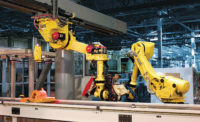Emerging technologies are said to be paradoxical. They hold both promise and peril for the societies that develop and use them. The paradox usually comes not from the technology itself, but how society decides to use it, or how it could potentially be used.
One example of such a conscience-based dilemma can be found in the work and life of nuclear scientist J. Robert Oppenheimer, as portrayed in the documentary, “The Day After Trinity.” Upon shepherding the Manhattan Project to a successful, operational atomic bomb, he exclaimed, “I have become death.” Witnessing the destructive power of his creation at the New Mexico tests, Oppenheimer went from being the “father of the A-bomb” to one of the most vocal opponents of nuclear power.
More recently, a similar debate has arisen over 3-D printing technology. One objection is the technology’s ability to produce a functioning gun, obfuscating the laws and restrictions on obtaining and using a firearm. The vision of the misuse of technology such as 3-D printing becomes even larger and more insidious when considering bio-medical technology. In the case of 3-D printing, it is the ability to produce human tissue and organs and, using a little hyperbole, potentially “print out” a human being from your desktop.
Many books and essays exist discussing the ethics and implications of biology as a human technology. Robert Carlson’s “Biology Is Technology” explores “the science of biological systems and the technology used to manipulate them.” A description of Carlson’s work alludes to computational and laboratory abilities that can “facilitate the engineering of biological artifacts, up to and including organisms and ecosystems,” meaning items can be constructed virtually, tested via mathematical models, and produced in the real world.
Ultimately, the debate over promise versus peril, particularly in the idea of power, availability and application, raises the question of who gets to use it, and to what end.
Unlike the discourse over bio-medical technology, the deliberations at this year’s VISION show in Boston won’t keep you up at night. The talk on the show floor was smart cameras—from their image sensors to interfaces to software and their growth into applications outside of machine vision.
Not long ago, software became the King of progress in machine vision. However, as evidenced by the VISON show, the advances in technology that are allowing for more processing power in a smaller package are driving attention back to improvements in hardware. One such idea is designing hardware with an open architecture, allowing smart cameras to work with virtually any software. Yet another is the ability to build powerful processors—ones that would be right at home in the latest PC—right into the smart camera without affecting size. And the practical comparison between charge-coupled device (CCD) or complementary metal-oxide semiconductor (CMOS) sensors continues.
Whether you attended the VISION show and want to compare notes, or just want to get your mind off the prospect of printing yourself out at work, check out Ben Dawson’s article, “Smart Cameras: Yesterday, Today and Tomorrow” in this month’s Vision & Sensors.
Enjoy and thanks for reading!





